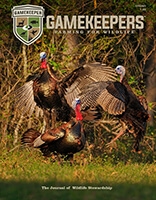The pileated woodpecker (Dryocopus pileatus) is best known for its flaming red Mohawk-style crest, incessant drumming, and large size. It’s the largest woodpecker living in North America, excluding the ivory-billed woodpecker, which is considered extinct. The pileated is non-migratory and highly territorial, living year-round and at all forest levels within its home range. Its distribution wraps around North America—from the eastern half of the U.S. into Canada and down into the Pacific Northwest. Forested habitats that feature late successional, old-growth forests with dead, weakened, and decaying trees are essential for nesting and foraging.
The pileated is easily identified by being big, beautiful, and loud. The crow-sized bird measures 16 to 19 inches in length, with an impressive 26- to 30-inch wingspan. Its flight is best described as strong and direct, with an undulating rise-and-fall pattern—flap, flap, flap, drop. Their stunning black body, white underwings, and black-and-white striped head and neck capped with a pointed red crest contrast boldly against its brown/green habitat. The male sports a red malar stripe, or moustache (the female’s is black), and a red crest that extends to the bill. The pileated is often heard before it’s seen, making a variety of calls from soft chucks to an unmistakable avian version of hysterical laughter in an escalating and repeated cuk, cuk, cuk.
The pileated woodpecker’s chisel-like bill is used to bore nest cavities, drill for food, and drum. Both sexes use their bills in a jackhammer-like fashion—called drumming—to sound alarms, proclaim territory, and attract mates. Drumming is a deep, rolling sound that starts slowly, accelerates, then slows again. It resonates over long distances, especially when a bird beats on a hollow tree.
Large rectangular holes in trees are the woodpecker’s foraging signature. It can drill deeper into a tree’s cambium than most other woodpeckers to extract insects using its long, barbed tongue coated in sticky saliva. Excellent hearing helps pileated woodpeckers detect insects within wood. Carpenter ants constitute more than half of the bird’s diet, along with wood-boring beetle larvae, termites, ants, caterpillars, fruits, berries, and nuts.
Pileated woodpeckers are monogamous and work as a team when excavating a nest cavity in a dead—or sometimes live—tree. It takes several weeks to complete a nest, which measures 10 to 24 inches deep. A clutch of three to five white eggs is incubated by both parents for about 15 to 18 days. Both parents feed the young by regurgitation. Fledging occurs at about one month old, and the nest is abandoned once the brood is raised. Nestling predators include martens, squirrels, rat snakes, and gray foxes. Adults can be preyed upon by eagles, hawks, and various owls.
The pileated woodpecker is considered a keystone species because its presence benefits other wildlife by creating habitats through excavation behavior. It helps control damaging forest pests and removes large amounts of wood from trees, speeding decomposition and nutrient cycling. This intriguing bird can sometimes be a nuisance due to incessant drumming and damage to trees or homes in residential areas. Though the pileated woodpecker is non-migratory, it is protected under the U.S. Migratory Bird Treaty Act. Overall, populations are stable to increasing, and the species is listed as Least Concern on the International Union for Conservation of Nature (IUCN) Red List of Threatened Species.
Did you know…
*nicknames for the pileated woodpecker include log cock, wood hen, carpenter bird, laughing woodpecker and Indian hen.
*the term pileated refers to the head’s fiery crest. It’s derived from the Latin word, pileatus, meaning capped, as in a fitted conical hat worn by ancient Romans.
*the bird’s toes are arranged in a zygodactyl pattern—2 forward and 2 backward for climbing and grasping a tree.
*abandoned woodpecker nests provide shelter, nest sites and/or forage opportunities for many forest creatures—songbirds, owls, bats, flying squirrels, raccoons and tree-nesting ducks.
*pileated woodpeckers strike wood thousands of times a day. Sponge-like rear skull bones, a well cushioned brain cavity and minimal cerebrospinal fluid help absorb the repeated jarring impacts and prevent brain damage.
*When drumming into wood the bird’s strike rates can reach more than 15 beats per second, in 2 to 3 second bursts. These are typically repeated every 40 to 60 seconds, four to seven times in succession.
-
Join our weekly newsletter or subscribe to Gamekeepers Magazine.
Your source for information, equipment, know-how, deals and discounts to help you get the most from every hard-earned moment in the field.









